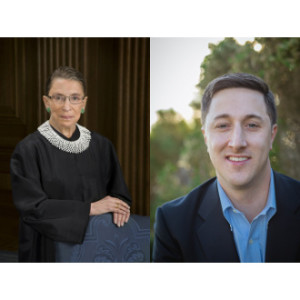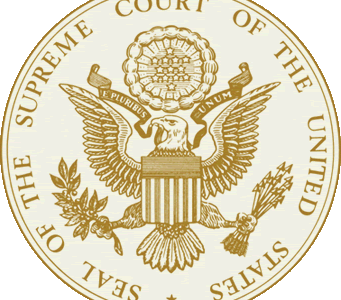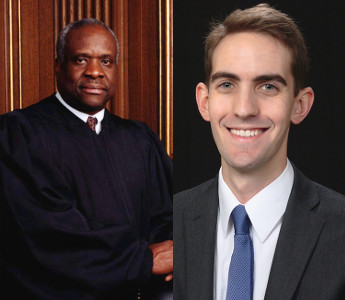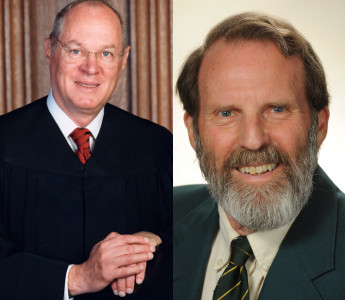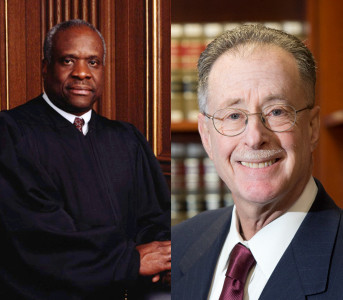Evenwel v. Abbott, 578 U.S. ___ (2016) (Ginsburg, J.).
Response by Professor Derek Muller
Geo. Wash. L. Rev. Docket (Oct. Term 2015)
Slip Opinion | New York Times | SCOTUSblog
Evenwel v. Abbott: A New Attempt to Define “One Person, One Vote”
“One person, one vote” is a popular mantra, one nearly1 inviolable in our American jurisprudence. But what that mantra means is another matter.2 It has generally been understood that representative bodies, such as state legislatures, must draw districts with roughly equal numbers of people in them. In its decision in Evenwel v. Abbott,3 the Supreme Court reaffirmed that people, not voters, may be the basis for drawing legislative districts—and left for another day whether this is be the only permissible basis for drawing districts, albeit with some clues for future litigants.
By 1960, some states had failed to redraw their legislative districts in several decades, leaving adjacent districts with vastly different populations. A voter in an overcrowded district had less voting power than one in a rural district. Voters in highly populated districts had a single representative to serve many constituents; voters in a rural district had greater access to their single representative. Other states had different houses of the legislature similar to the federal Congress: a lower chamber with districts based upon total population, and an upper chamber with districts based upon county lines or some other political unit.
The Supreme Court, in one of a string of cases, reconstituted the legislatures of several states through its opinion in Reynolds v. Sims in 1964.4 State legislatures must draw legislative districts on the basis of “one person, one vote.” The Court’s language in these cases was sloppy when it demanded equal numbers in each district, using words like “people,” “citizens,” and “voters” often interchangeably. In the months that followed, states (and localities) fell in line, usually drawing districts with roughly equal numbers of people in them.
In Evenwel, plaintiffs hoped to challenge this typical practice with a different theory. “One person, one vote,” they argued, was principally about the rights of voters. In Texas, dramatic disparities existed between districts, not on the basis of total population, but on the basis of voters. Some Texas state legislative districts had significantly more non-citizens than others—that meant voters had more power in districts with a substantial number of non-citizens. Therefore, plaintiffs argued, Texas ran afoul of “one person, one vote” when it drew districts on the basis of roughly equal numbers of people; it should have drawn districts on the basis of roughly equal numbers of voters.
A three-judge panel rejected plaintiffs’ claims, and the Supreme Court unanimously affirmed. Justice Ginsburg wrote an opinion on behalf of six justices, with a simple holding: “a State may draw its legislative districts based on total population.”5 The majority opinion looked at constitutional history, Supreme Court precedent, and the practice of the states since Reynolds, all of which pointed in the direction that permitted Texas to use total population as a basis for drawing legislative districts. It was ostensibly straightforward, but the intrigue comes in the details, and what it may mean for the future.
While Evenwel only squarely presented the situation of whether Texas may use total population, a lingering question is whether, and when, states (or localities) may use some basis other than total population. In Baker v. Carr,6 for instance, the origin of the current “one person, one vote” cases, Tennessee drew its legislative districts on the basis of “voting population.”7
Plaintiff-appellants did have a case on their side that squarely addressed the issue, at least one that permitted a non-population base for redistricting—Burns v. Richardson,8 in which the Supreme Court sanctioned Hawaii’s redistricting plan based on registered voters. Hawaii’s plan was approved due to the state’s “special population problems,” as the majority opinion noted—it had a substantial temporary military population, and Hawaii wanted to account for that.9
But “account for that,” of course, implies that sometimes total population is not a good way to comply with “one person, one vote,” and other measures are better. True, the Court unanimously agreed that Texas is not required to use a non-population basis, like voters, when drawing its districts. But why did the Supreme Court sanction some other basis for a “special . . . problem[]” like that in Hawaii?10 The majority never explains—Burns, the most impressive argument for the appellants’ case, is never mentioned again. The majority also notes that several states do adjust redistricting and draw lines on something other than a pure population basis—a few states exclude nonresident members of the military, or inmates incarcerated in the state. These exceptions, too, vanish from the remainder of the analysis.
Perhaps that’s appropriate, as the Court is faced only with the question of whether Texas was required to use a voter-based population, or whether it was permissible for Texas to draw districts on the basis of total population, as it had done. It did not face the question of whether Texas was permitted to use some other population basis. Indeed, the Court expressly stated that “we need not and do not resolve whether, as Texas now argues, States may draw districts to equalize voter-eligible population rather than total population.”11 But there are some signs that the Court’s logic may extend to what it disclaimed doing.
The majority opened, for instance, with an examination of the history surrounding the basis for allocating congressional representatives. The Constitution in fairly straightforward language notes that apportionment of congressional representatives to the states occurs according to “their respective Numbers,” the “whole Number of free persons,” “excluding Indians not taxed,” and “three fifths of all other Persons.”12 When Congress enacted the Fourteenth Amendment, it intended to extend the guarantee of representation to all newly-freed slaves, continuing to ensure that congressional representation would be allocated on the basis of population, not voters.13
This is two steps removed from the issue in Evenwel. First, the Court linked the allocation of representatives to the population basis for drawing congressional districts. The Court in Wesberry v. Sanders14 had done just that—as congressional districts were created on the basis of total numbers of persons, so too must redistricting occur within the framework of “one person, one vote.” And second, the analogy of “one person, one vote” extends to state legislative districts, too—after all, the Evenwel Court explained, it would be odd to say that apportionment in Congress is required to be based on total population, but that Texas is forbidden from using total population in drawing its state legislative districts.
But all this turns on what “one person, one vote” means. Does it mean total population, or voters? Or is it simply agnostic and leaves the decision to the state to choose among these permissible options? While Wesberry linked apportionment to redistricting, it never squarely held that only total population was permissible for redistricting—despite the fact that only total population was permissible for apportionment (subject to the requirement that each state receive at least one representative). The Court in Evenwel suggested otherwise: “[T]his theory underlies not just the method of allocating House seats to States; it applies as well to the method of apportioning legislative seats within States.”15
Justice Alito was sufficiently worried about this type of reasoning that unnecessarily expanded Wesberry that he concurred in the judgment only.16 Joined by Justice Thomas, he spent extensive time explaining that the allocation of congressional representatives to the states has little to do with how to apportion congressional districts within the states—for instance, Justice Alito noted, every state gets at least one member in the House, regardless of population. The majority and Justice Alito sparred over several footnotes about what all these things meant.
Finally, the Court used strong language on its views of political theory near the end of its opinion: “representatives serve all residents, not just those eligible or registered to vote” and that “each representative” ought to be “subject to requests and suggestions from the same number of constituents.”17 In the event some jurisdiction in the future attempts to use some basis other than total population in its redistricting system, it is highly likely that this political theory will be invoked repeatedly. These statements were not just political theory cited approvingly, but as if these were the Court’s settled beliefs on how political representation ought to be.
Perhaps this parsing of the opinion reads too much—it might be that this case does not stand for so bold a proposition. While the Court does not address precedent like Burns, it does not distinguish it or minimize it, either. Lower court opinions that had previously deferred on the question of the appropriate apportionment base were also cited without disapproval. And if we take the Court at its word, it has genuinely reserved the matter of whether states may use a non-population basis for drawing districts for another day.
But it is worth noting that the simple and unanimous decision of the Court may lead to the adoption of a narrower theory of “one person, one vote,” one that leaves less discretion to the states. Whether states (or localities) may exclude incarcerated prisoners, non-citizens, or non-voters, among other theories, when drawing districts may be tested in the very near future—and the Court’s logic in Evenwel will surely be at the center of the disputes.
- It is worth noting that Justice Thomas found in Evenwel that the doctrine of “one person, one vote” was a judicial creation unsupported by the Constitution. See Evenwel v. Abbott, No. 14-940, slip op. 1 (U.S. Apr. 4, 2016) (Thomas, J., concurring); accord Michael W. McConnell, The Redistricting Cases: Original Mistakes and Current Consequences, 24 Harv. J.L. & Pub. Pol’y 103 (2000); Earl M. Maltz, Inconvenient Truth: Originalism, Democratic Theory and the Reapportionment Cases, Miss. L.J. (forthcoming).
- See Sanford Levinson, One Person, One Vote: A Mantra in Need of Meaning, 80 N.C. L. Rev. 1269 (2002).
- Evenwel v. Abbott, No. 14-940, slip op. 1 (U.S. Apr. 4, 2016).
- Reynolds v. Sims, 377 U.S. 533 (1964).
- Evenwel, slip op. at 1.
- Baker v. Carr, 369 U.S. 186 (1962).
- See generally Derek T. Muller, Perpetuating “One Person, One Vote” Errors, 39 Harv. J.L. & Pub. Pol’y __ (forthcoming 2016).
- Burns v. Richardson, 384 U.S. 73 (1966).
- Id. at 94.
- Evenwel, slip op. at 4.
- Id. at 19.
- U.S. Const. art. I, § 2, cl. 3.
- Evenwel, slip op. at 10–11.
- Wesberry v. Sanders, 376 U.S. 1 (1964).
- Evenwel, slip op. at 12.
- Id. at 1 (Alito, J., concurring).
- Id. at 18–19 (majority opinion).
- See Calvin v. Jefferson Cty. Bd. of Comm’rs, No. 4:15CV131-MW/CAS, 2016 WL 1122884 (N.D. Fla. Mar. 19, 2016).
Recommended Citation
Derek Muller, Response, Evenwel v. Abbott, Geo. Wash. L. Rev. Docket (Apr. 05, 2016), http://www.gwlr.org/evenwel-v-abbott-a-new-attempt-to-define-one-person-one-vote.

